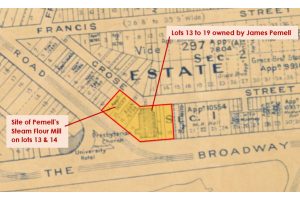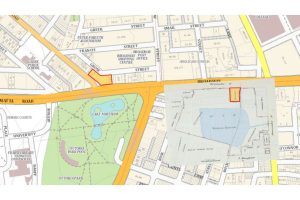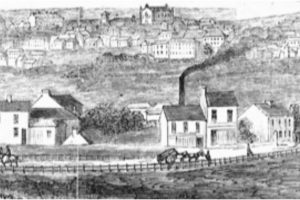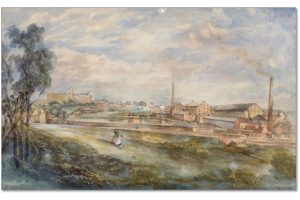Rodney Hammett & Sybil Jack, Bulletin 3/2022, May 2022

When I was writing the story on the Federation Flour packaging and the Brockhoff flour mill at the corner of Glebe Point Rd and Broadway in Bulletin 1/2022, Sybil Jack asked about an earlier steam flour mill, operated by James Pemell, at the same site.1 That was the impetus for a collaboration and follow-up story. First, though, it is relevant to understand some of the background to Sydney’s early flour mills, so the reader is encouraged to review Sybil’s detailed article on flour mills in The Dictionary of Sydney
James Pemell (1816-1906) was the son of James Pemell, a London baker. James jnr arrived in Sydney around 1836 and soon became a baker in the city he was to make his home. He married English-born Jane Fish in 1839 and they had two daughters and two sons. Pemell initially bought wheat from the farmers in the Liverpool, Campbelltown, Camden and surrounding districts, and sent the wheat for milling to a windmill in William St. But James was an astute businessman so, to improve his margin and to have a better control of his business, he needed his own mill and one that did not depend on the wind.

Pemell purchased property in Grose’s Bishopgate estate (Lots 13 and 14 in Section 1) when Joseph Hickey Grose put it up for auction due to insolvency in May 1845. Pemell paid £32 10s. Two years later, in 1847, Pemell purchased lot 15 for £45 and, in 1850, he purchased lots 16 to 19 for £375.2 (See Figure 1). A steam flour mill was constructed on lots 13 and 14 with a water supply from a well on the property and a pipeline from the nearby pond across Parramatta Rd (now Lake Northam) in Victoria Park (see Figure 2).

James’ baking business flourished; two tons of flour were reportedly being baked each night. This changed in 1851 when the news of gold in country New South Wales and Victoria led to an exodus of workers from the city, leaving Pemell with no carters for his freshly-made bread. His solution was to sell the bread carts and horses, which ended this phase in his career. 3 As well as labour problems, Pemell was unable to obtain clean water for his Glebe steam mill. This was due, in part, to the Victoria Park pond water being polluted by bus-horses being watered and washed there. Eventually Pemell abandoned this Glebe mill for a better one in Parramatta St (today’s Broadway). The Glebe land was sold in 1860 for £2,000. Lots 13 & 14 were described on the title as ‘land together with flour mill thereon erected and all plant machinery implements, and things belonging to or connected therewith.’4
The Presbyterian Church, through its elders Joseph Paxton, William Elphinstone (the younger), Andrew McCredie, William McCredie and James Douglass, purchased lots 15, 16, 17 and part of lot 18 in 1875.5 Their new church was constructed largely over lots 16 and 17 and part of lot 18 (the church can be seen on the 1910 base-map in Figure 1). Land that was surplus to the church’s needs, lot 15 and a small part of lot 16, was transferred to James Balfour Elphinstone who built the existing building at 279 Broadway. The Brockhoff family purchased J.B. Elphinstone’s building in 1906 for use as an office. In 1938, the Brockhoffs purchased the then vacant church site (the church had been moved to Bridge Rd in 1927, where it stands today). It was on this site that the Brockhoffs constructed their own flour mill.6 The remaining part of lot 18 was purchased by Brockhoff & Co in 1941. Brockhoff & Co sold all their Glebe property in 1966.

Pemell’s Chippendale land was part of Robert Cooper’s (1824-1852) industrial complex that had previously been the British Military Garden (c. 1814-1824). Cooper was granted just over 17 acres of land where he developed a distillery, flour mill and sugar house, as well as a dam to supply water for the steam used in these establishments. Warehouses and dwellings were also built on the site. The flour mill was managed by Henry Smithers Hayes in the 1840s (see Lyn Collingwood’s article in Bulletin 05/2020). It is likely that Cooper sold the flour mill and land to Pemell at about that time, as Cooper went into voluntary bankruptcy in 1852. The property was certainly known as ‘Pemell’s mill’ by October 1851; in that month, newspapers carried reports of an employee’s death there following an accident.7
In 2015 and 2019, some of the Cooper’s site, including a part that became Pemell’s mill, was the subject of detailed archaeological investigations and reports when new buildings were planned for the site.8 These investigations have helped locate the exact position of numerous historical structures.
The earliest Sands Directory, dated 1858, shows the occupants on the southern side of Parramatta St, west of Abercrombie St. St Benedict’s Church was (and still is) at the corner of Abercrombie St and Parramatta St. Heading west, the next property was the Brisbane Distillery, then, at No 124, was James Pemell’s Steam Flour Mills, followed by the Colonial Sugar Refinery’s stores and works.
Some of these properties can be seen in Samuel Elyard’s 1868 watercolour titled Colonial Sugar Co, Chippendale (Figure 3). In the background of the watercolour can be seen Sydney University’s quadrangle and Great Hall and Glebe can be seen in the middle background. Two chimneys with their associated buildings can be easily seen just beyond a road which is probably Abercrombie St. A dam (Brisbane Reservoir) is to the left of these buildings. The chimney and buildings on the far right of the painting are probably Pemell’s steam flour mill.

With the end of the goldrush, Pemell’s business was again profitable; enough to allow him to sell his Balmain residence (Bleak House) and take his wife and three children on a European trip from March 1861 to October 1863.9 Back in New South Wales, he resumed his political career when elected as the Member for Canterbury in February 1865, a position he held until May 1869. Pemell had previously held public office as a City of Sydney Councillor (1851-1852) and as a member of the NSW Legislative Assembly (1859-1860). His fortunes were dealt a blow in 1870 when his Chippendale mill was destroyed by a fierce fire that started in the early hours of Sunday 18 December. In June 1871 the site was described as ‘the remains of Pemell’s mill’ and in June 1873 ‘Pemell’s old mill’.
Undeterred, Pemell started milling again at Hay St, Haymarket. By this stage, his milling and commodities business ownership included his sons James (1846-1931) and Peter (1848-1932).
Pemell’s wife, Jane, died in 1882. James Pemell lived to the grand age of 90 and died at his Newtown home on 26 March 1906. He and his wife are buried in the Randwick Cemetery.
Other reading: Sybil Jack’s article, Blackwattle Bay and its Creek, in Bulletin 05/2020, and Shirley Fitzgerald’s article, From Pig Mary and offal to desirable park, in Bulletin 05/2008.
Notes: 1 Pemell’s steam flour mill is also mentioned in Max Solling’s History of Glebe, p.61, 2nd para; 2 NSW Land Register Services: Bk 9 No 333; Bk 13 No 837 & Bk 20 No 874; 3 Trove: Sydney Mail, Wed 4 Apr 1906, p. 877; 4 NSW LRS: Bk 98 No 385; 5 NSW LRS: Bk 148 No 465; 6 NSW LRS: Bk 796 No 429, Vol 2071 Fol 16 & Vol 5058 Fol 49; 7 Trove: Empire, Mon 6 Oct 1851, p.3; 8 Archaeological Test Excavation Report by the Archaeological Management & Consulting Group, 2019 and Archaeological Assessment & Impact Statement by Casey & Lowe Pty Ltd, 2015, both for UTS; 9 Sale of his residence Bleak House in Balmain with his imminent departure to England – SMH, Wed 9 Jan 1861, p. 6. Letter in SMH from passengers who had arrived in England after their passage from Sydney on the La Hague – SMH, Thu 13 Jun 1861, p. .4. Letter in SMH from passengers recently arrived in Sydney from England on the La Hague – SMH, Fri 30 Oct 1863, p. 4.









There are no comments yet. Please leave yours.